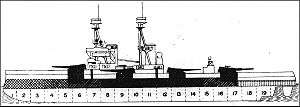HMS Bellerophon (1907)
- See HMS Bellerophon for other ships of the same name.
 HMS Bellerophon in 1909. | |
| History | |
|---|---|
| Name: | HMS Bellerophon |
| Laid down: | 6 December 1906 |
| Launched: | 27 July 1907 |
| Commissioned: | 27 February 1909 |
| Fate: | 8 November 1921 Sold for scrap |
| General characteristics | |
| Class and type: | Bellerophon-class battleship |
| Displacement: | 18,600 tons (18,900 tonnes) |
| Length: | 526 ft (160 m) |
| Beam: | 82 ft 6 in (25.15 m) |
| Draft: | 31 ft 5 in (9.58 m) |
| Speed: | 20.75 knots (38.43 km/h) |
| Complement: | 733 officers and men |
| Armament: |
|
HMS Bellerophon was a dreadnought of the Royal Navy. She was the lead ship of the Bellerophon class, and the fourth Royal Navy vessel to bear the name of the mythic Greek hero. Built at the Royal Dockyard in Portsmouth and completed in 1909, Bellerophon first joined the 1st Battle Squadron and then upon the outbreak of war joined the 4th Battle Squadron where she remained until 1919. She was present at the Battle of Jutland where she fired sixty-two 12 inch rounds and received no damage. With the end of the war she was placed in the Reserve Fleet and sold for scrap in 1921 before being taken to the breakers two years later.
Design


While revolutionary, HMS Dreadnought had been revealed to have certain shortcomings. Her secondary armament was judged to be insufficient to combat the increased size of torpedo boats, regarded at the time as the principal threat to major surface warships. Hence her secondary armament was strengthened and her anti-torpedo protection was improved in the form of continuous anti-torpedo bulkheads running from the front of the fore magazine to the rear of the aft magazine.
Externally, Bellerophon and the sister-ships of her class appeared similar to Dreadnought, having the same main armament layout of 5 twin 12 inch mounts, a secondary armament of 16 single-mounted 4 inch mounted in casemates on the superstructure and upon the deck, and lighter guns atop the turrets. A torpedo-control tower aft completed the profile. The Bellerophon class was different in having two tripod masts rather than the single such mast shipped in Dreadnought to facilitate sea keeping in peacetime. The 12 inch British dreadnoughts would be unique when later they were fitted with two sets of fire-control equipment.
She was built with 18 Babcock boilers arranged in 3 groups of 6. Her machinery, constructed by Fairfield, consisted of 4 Parsons single reduction steam turbines driving 4 shafts producing 23,000 shp (17 MW). Due to the scaling down of coal bunkerage, her range of 5,720 nautical miles (10,593 km) at 10 knots (18.5 km/h) was considered middling at best. Her machinery was provided by Fairfield Shipbuilding and Engineering Company, Govan.
Career
Laid down the month HMS Dreadnought was commissioned, Bellerophon was the name ship of the Bellerophon class and was the first to be completed. The cost of building was £1,763,491, making her the most expensive of her class. She was laid down on 6 December 1906, launched 27 July 1907 and commissioned into the fleet on 20 February 1909. On trials she made 21.25 knots, a speed lower than that of her sisters due to inferior shp; she developed 25,061 shp, as opposed to HMS Superb's 27,407 shp and HMS Temeraire's 26,966 shp.
Upon completion she joined the 1st Battle Squadron of the Home Fleet. On 26 May 1911 she was in a collision with the battlecruiser HMS Inflexible. Bellerophon received damage whilst Inflexible took bow damage which put her in the dockyard until November. On 1 August 1914, after the Fleet Mobilisation and the formation of the Grand Fleet, she joined the 4th Battle Squadron.
On the journey to the fleet anchorage at Scapa Flow, Bellerophon collided with the vessel SS St Clair on 27 August off the Orkney Islands but sustained no major damage. In May 1915, she headed to the Royal Dockyard, Devonport for a refit.

At the Battle of Jutland the vessel was under the command of Captain Edward F. Bruen in the Fourth Division (commanded by Rear Admiral Alexander Duff) of the 4th Battle Squadron under Vice Admiral Doveton Sturdee. The 4th Battle Squadron deployed behind the 2nd Battle Squadron in line ahead during the main part of the battle, and Bellerophon fired 62 12 inch rounds without receiving one hit.
After the battle she swept with the other vessels of the Grand Fleet regularly. Between June and September 1917 she served as the flagship of the 2ic of the 4th Battle Squadron, carrying the flag of Rear Admiral Roger Keyes and then Rear Admiral Douglas Nicholson. Unlike her sister ships she was not deployed to the Eastern Mediterranean Squadron in October 1918.
Placed in reserve in 1919 by dint of their less powerful main armament (in comparison to the later super-dreadnought-type ships of the Orion, King George V, Iron Duke, Queen Elizabeth, and Revenge classes), she and sister ship Superb were used as Gunnery Schools (Turret Drills); her sister Temeraire became a cadet training ship (seagoing). With a view towards both the relative obsolescence of the class and the need for compliance with the terms of the Washington Naval Treaty that was shortly to be signed by Great Britain, HMS Bellerophon was sold to the breakers in November 1921 and broken up in 1923.
The ship in profile can be seen on the ten-dollar note from the Royal Bank of Canada issued in 1913.
External links
| Wikimedia Commons has media related to HMS Bellerophon (1907). |
